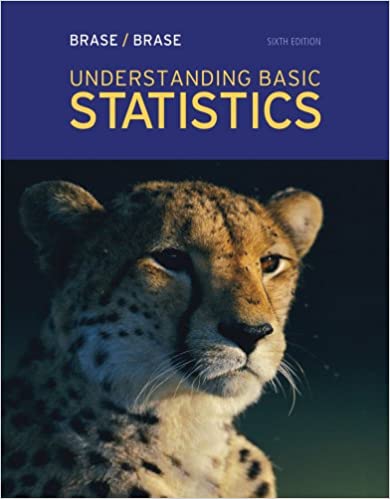
Understanding Basic Statistics 6th Edition by Charles Henry Brase,Corrinne Pellillo Brase
Edition 6ISBN: 978-1111827021
Understanding Basic Statistics 6th Edition by Charles Henry Brase,Corrinne Pellillo Brase
Edition 6ISBN: 978-1111827021 Exercise 41
For Problems 9-17 assume that the distribution of differences d is mound-shaped and symmetrical.
Please provide the following information for Problems 9-17.
(a) What is the level of significance State the null and alternate hypotheses. Will you use a left-tailed, right-tailed, or two-tailed test
(b) Check Requirements What sampling distribution will you use What assumptions are you making Compute the value of the sample test statistic.
(c) Find (or estimate) the P -value. Sketch the sampling distribution and show the area corresponding to the P -value.
(d) Based on your answers in parts (a)-(c), will you reject or fail to reject the null hypothesis Are the data statistically significant at level
(e) Interpret your conclusion in the context of the application.
In these problems, assume that the distribution of differences is approximately normal.
Note: For degrees of freedom d.f. not in the Student's t table, use the closest d.f. that is smaller. In some situations, this choice of d.f. may increase the P -value by a small amount and therefore produce a slightly more "conservative" answer.
Wildlife: Wolves In environmental studies, sex ratios are of great importance. Wolf society, packs, and ecology have been studied extensively at different locations in the U.S. and foreign countries. Sex ratios for eight study sites in northern Europe are shown on the next page (based on The Wolf by L. D. Mech, University of Minnesota Press):

It is hypothesized that in winter, "loner" males (not present in summer packs) join the pack to increase survival rate. Use a 5% level of significance to test the claim that the average percentage of males in a wolf pack is higher in winter.
Please provide the following information for Problems 9-17.
(a) What is the level of significance State the null and alternate hypotheses. Will you use a left-tailed, right-tailed, or two-tailed test
(b) Check Requirements What sampling distribution will you use What assumptions are you making Compute the value of the sample test statistic.
(c) Find (or estimate) the P -value. Sketch the sampling distribution and show the area corresponding to the P -value.
(d) Based on your answers in parts (a)-(c), will you reject or fail to reject the null hypothesis Are the data statistically significant at level
(e) Interpret your conclusion in the context of the application.
In these problems, assume that the distribution of differences is approximately normal.
Note: For degrees of freedom d.f. not in the Student's t table, use the closest d.f. that is smaller. In some situations, this choice of d.f. may increase the P -value by a small amount and therefore produce a slightly more "conservative" answer.
Wildlife: Wolves In environmental studies, sex ratios are of great importance. Wolf society, packs, and ecology have been studied extensively at different locations in the U.S. and foreign countries. Sex ratios for eight study sites in northern Europe are shown on the next page (based on The Wolf by L. D. Mech, University of Minnesota Press):

It is hypothesized that in winter, "loner" males (not present in summer packs) join the pack to increase survival rate. Use a 5% level of significance to test the claim that the average percentage of males in a wolf pack is higher in winter.
Explanation
a)
We use the right-tailed test.
b)
...
Understanding Basic Statistics 6th Edition by Charles Henry Brase,Corrinne Pellillo Brase
Why don’t you like this exercise?
Other Minimum 8 character and maximum 255 character
Character 255


